This article was published in Scientific American’s former blog network and reflects the views of the author, not necessarily those of Scientific American
In this second article on maniraptorans, we look at the main groups that constitute this clade: you’ll need to remember the main group names if the trends and tendencies discussed in later parts of this series are to make any sense. The previous article – part 1 – looked briefly at maniraptoran origins and at the fact that maniraptorans are nested within coelurosaurian theropods. Ok, onwards…
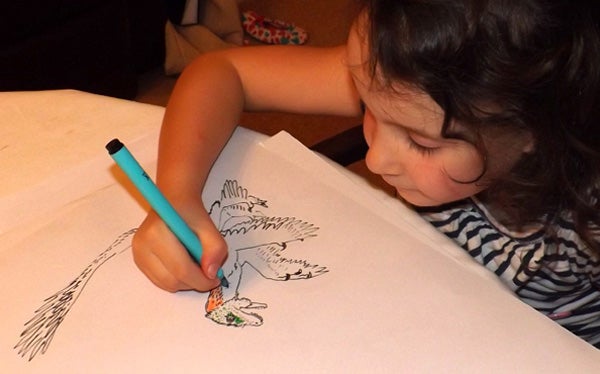
Apparently there are - even today - people who don't know that Velociraptor-like maniraptorans were fully feathered, just like birds. Here's a young human drawing a microraptorine dromaeosaur. Image by Darren Naish.
The paravians. Within Maniraptora, it’s near-universally agreed that avialans (the members of the bird lineage: read on) are especially closely related to troodontids (properly, Troodontidae) and dromaeosaurs (properly, Dromaeosauridae), the three forming the clade Paraves. Yes, there’s disagreement as goes the exact relationship between the three main paravian lineages (are troodontids especially close to avialans, are dromaeosaurs especially close to avialans, or are troodontids and dromaeosaurs closer to each other than they are to avialans?), but that detail isn’t important to us here, since the early members of all three groups are so similar that it doesn’t make much difference as goes the larger picture.
On supporting science journalism
If you're enjoying this article, consider supporting our award-winning journalism by subscribing. By purchasing a subscription you are helping to ensure the future of impactful stories about the discoveries and ideas shaping our world today.
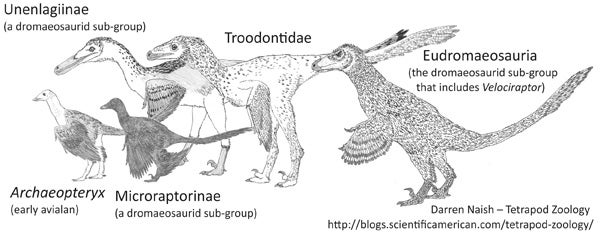
A paravian montage. Images by Darren Naish, from my in-prep textbook project.
What’s the deal with the word ‘avialan’? This is the vernacular term for Avialae, a name applied to the lineage that includes Archaeopteryx, living birds, and all descendants of their most recent common ancestor (actually, several different definitions of Avialae have been published, but… ugh, I don’t want to get into that here). You’ll appreciate that any understanding of Avialae anchored on Archaeopteryx is potentially problematic given the publication of studies that don’t find Archaeopteryx to belong to the lineage that includes living birds – we’ll come back to that in a minute.
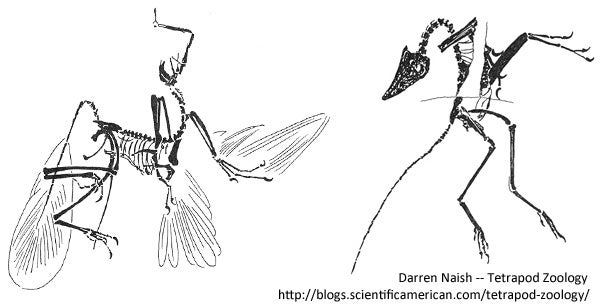
The Jurassic maniraptoran Archaeopteryx is known from several fantastically well-preserved, articulated skeletons, two of which are shown here. If this dinosaur was discovered today, would we definitely decide that it should be proclaimed "the earliest bird"? Of course not, but history happened the way it did. Images by Darren Naish.
And I should also say that experts disagree as to whether ‘Avialae’ or ‘Aves’ is the ‘best’ name for the bird lineage, some of them arguing that Aves is best restricted to the crown-group (the clade the contains living species and all descendants of their most recent common ancestor). Here, the term avialan is used to mean ‘the bird lineage’ within Maniraptora. I’d be quite happy, in fact, to use ‘bird’ as a synonym of ‘avialan’, but I’ve been told by certain colleagues that this should be avoided. Hm.
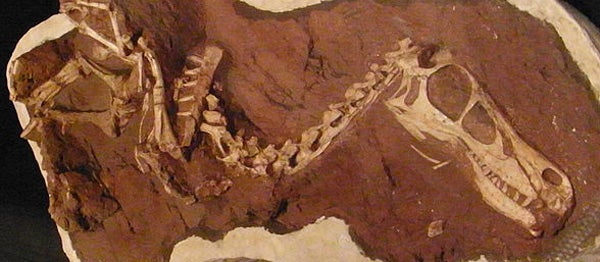
Dromaeosaurs and troodontids originated from small Archaeopteryx-like paravians and were so similar to members of the avialan lineage in life that - were we to travel back in time to the Jurassic or Cretaceous - we probably wouldn't be able to tell them apart. This is the exquisite skeleton of Linheraptor, a Mongolian dromaeosaur which is almost certainly, actually, the same as Tsaagan. Image by Kumiko, CC BY-SA 2.0.
Anyway… thanks to those spectacular Jurassic and Cretaceous fossils from China, we know today that non-avialan paravians were highly similar to early avialans in external appearance. Long, pennaceous feathers covered the hands and much of the arms, and also grew from the sides and tip of the tail. A continuous, extensive feathery pelage covered much of the rest of the body, including even some or much of the snout and even – in some groups – the feet. We’ve generally thought that those feathers not on the forelimbs and tail were loose, shaggy, filamentous feathers like those present in non-maniraptoran coelurosaurs but they might not all have been like this: recent studies show that even complex feathers end up looking loose and shaggy when subjected to decomposition, burial and crushing, and that the body of Archaeopteryx was covered in short pennaceous feathers (Foth et al. 2014). The scaly faces and scaly fingers still being shown in some life reconstructions of these animals do not appear to be accurate. Members of some non-avialan paravian lineages – the microraptorine dromaeosaurs, for example – had elongate, pennaceous feathers on their hindlimbs (even on their feet), but others did not.
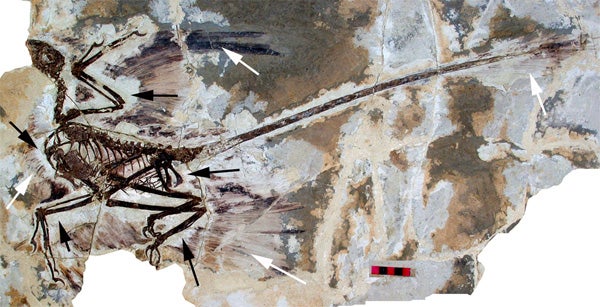
Dromaeosaurs like Microraptor, shown here, had long, pennaceous feathers on their arms, hands, legs, feet and tails. Feathers covered most of the rest of the animal as well. Image from Hone et al. (2010), CC BY 2.5.
In short, non-avialan paravians must essentially have looked like short-winged versions of Archaeopteryx, an insane concept when we consider that some of these animals (Utahraptor and other giant dromaeosaurs, for example) were giants of 6 m or more. Some of you will be familiar with this awesome, crowd-funded in-the-works range of toys which do fairly accurately depict what we now think as goes non-avialan paravian life appearance (check out the Kickstarter page here). I like them, but there some very minor details I think are wrong (like the scaly fingers).
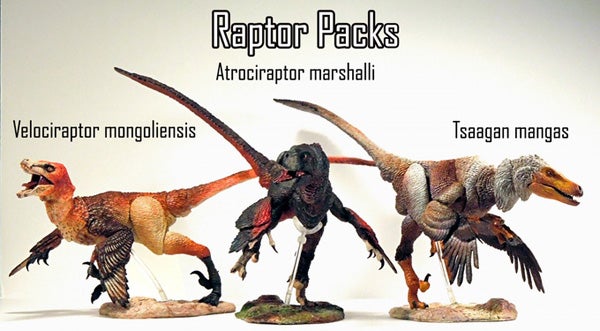
The Beasts of the Mesozoic figure range -- fully funded, so I understand. Image from the Kickstarter page here, used under fair use.
Having mentioned Archaeopteryx, here we come back to those studies which argue that Archaeopteryx is not actually a member of the branch that includes living birds but might actually be on the dromaeosaur or troodontid branch instead. This idea has been contested and might be wrong. Again, it doesn’t much matter as goes the general pattern of evolution among maniraptorans as a whole, given that Archaeopteryx is obviously so similar to early dromaeosaurs and troodontids. A few other small, Archaeopteryx-like Jurassic maniraptorans – including Anchiornis, Xiaotingia and Eosinopteryx – have also moved from branch to branch depending on the study concerned: they are dromaeosaurids (Senter et al. 2012, for Xiaotingia) or troodontids in some studies (Hu et al. 2009, Senter et al. 2012, Godefroit et al. 2013, Brusatte et al. 2014), early avialans in others (Foth et al. 2014, Lee et al. 2014).
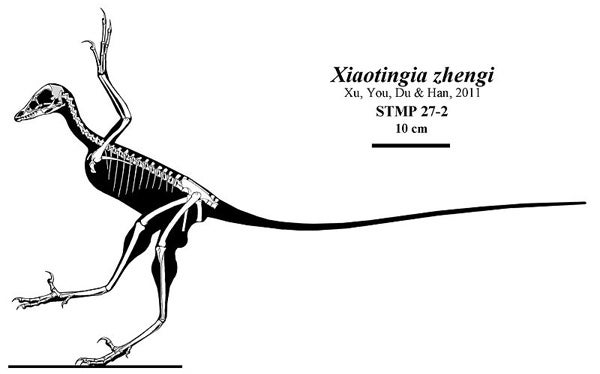
Skeletal reconstruction of Xiaotingia by Jaime Headden/Qilong, CC BY 3.0. Xiaotingia has variously been regarded as an early dromaeosaur, troodontid or avialan. Xiaotingia is one of several well-preserved 'pre-Archaeopteryx' maniraptorans now known to science: it’s from the Middle or Upper Jurassic of China.
The oviraptorosaurs. Let’s now move outside of Paraves. Oviraptorosaurs are most famously represented by the parrot-headed, often crested, toothless oviraptorids of Late Cretaceous eastern Asia. Then there are the similar but longer-limbed, longer-skulled caenagnathids, mostly associated with Late Cretaceous North America. These animals were mostly 1.5-2 m long but a few were giants: Gigantoraptor is somewhere in the oviraptorid + caenagnathid clade and was about 7 m long. The earliest oviraptorosaurs we know of – Caudipteryx from the Early Cretaceous of China and several similar forms – were small (less than 1 m long).
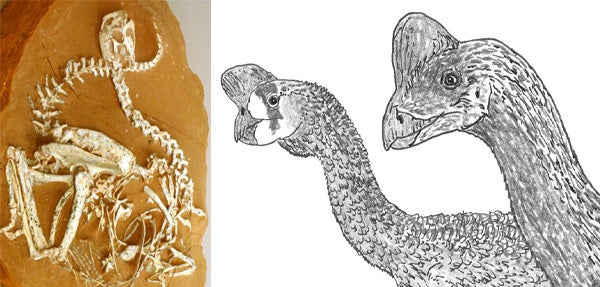
A number of oviraptorosaurs are known from spectacularly complete skeletons: they include Khaan mckennai from the Upper Cretaceous of Mongolia, shown at left. Image by Steve Starer, CC BY 2.0. Life reconstructions of an oviraptorid (at left) and caenagnathid by Darren Naish.
Oviraptorosaurs appear to be especially closely related to paravians – they’re very similar to them in possessing large, pennaceous feathers on the forelimbs and tail, and in fact advanced oviraptorosaurs are uncannily bird-like in various features of the braincase, quadrate and so on. Indeed it’s sometimes been proposed that oviraptorosaurs are closer to birds than are groups like dromaeosaurs (Maryańska et al. 2002). While we can’t rule this out entirely, it isn’t a good explanation for the character distribution we see, and it ignores the fact that early members of the oviraptorosaur lineage (like Caudipteryx) are less bird-like than the advanced forms. Oviraptorosaurs and paravians together form a clade termed Pennaraptora (Foth et al. 2014).
The therizinosaurs. Among the weirdest and (arguably) most exciting of Mesozoic dinosaurs are the therizinosaurs, a group best known for its large and gigantic, long-necked, broad-hipped, broad-footed, short-tailed Late Cretaceous species. These animals are so weird that, for a time, they were even considered to be sauropodomorphs or relatives of them, not coelurosaurian theropods at all. Detailed investigations of their anatomy, and the discovery of new early members of the group (or, at least, close relatives of the group) – namely Beipiaosaurus, Falcarius and Jianchangosaurus – demonstrate a position within Maniraptora.
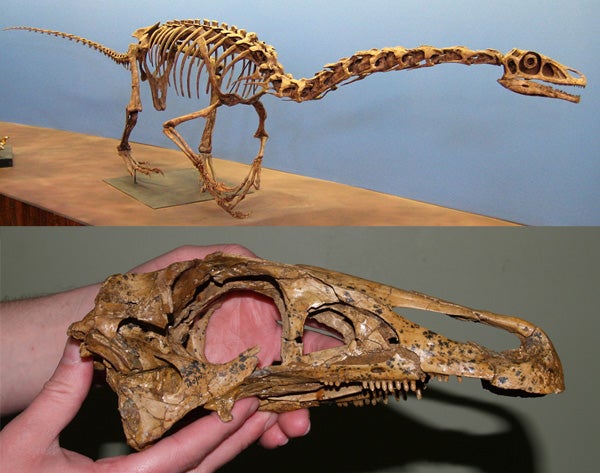
At top: the early, gracile therizinosaur Falcarius from the Barremian of Utah, on display at Utah Museum Natural History Museum. Image by Paul Fisk, CC BY-SA 2.0. Below: skull of the advanced, Late Cretaceous Mongolian therizinosaur Erlikosaurus. Image by Robert Loveridge, used with permission.
In a few respects, therizinosaurs are similar to oviraptorosaurs and an idea popular for a while was that the two might form a clade (it was sometimes termed Enigmosauria). The distribution of characters as we understand it at the moment better indicates that therizinosaurs are outside of Pennaraptora (Zanno 2010, Foth et al. 2014). This seems to be in keeping with the fact that, while fully feathered, therizinosaurs seem to lack pennaceous feathers. Their plumage appears to have been shaggy and filamentous, with long spines or strap-like structures distributed across the body.

Possible life appearance of a therizinosaur like Nothronychus from the Early Cretaceous of North America. I have depicted it with a shaggy, filamentous integument. Image by Darren Naish, produced for my in-prep giant textbook on vertebrate history.
The alvarezsaurs. Finally, we come to alvarezsaurs, a group that appears to have been widely distributed during Late Cretaceous times. In stark contrast to therizinosaurs, alvarezsaurs are very lightly built, have long to absurdly long, gracile hindlimbs, and hyper-short forelimbs with a much enlarged, heavily built thumb. The neck is very long and slender, the skull gracile and dainty, the snout is semi-tubular, and the teeth are tiny, simple and closely packed. All known species are less than 2.5 m long, with some being tiny (50 cm long or so). Combined, these and other features suggest that they were insectivores and perhaps even specialised ant- and termite-eaters that broke open rotting wood (Senter 2005, Longrich & Currie 2008), though exactly how this would work given the shortness of their arms remains difficult to understand.
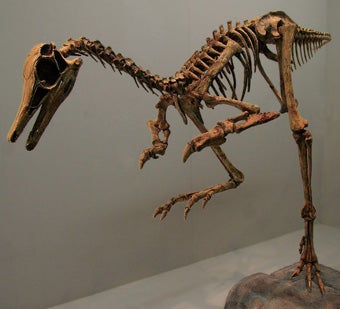
Reconstructed and posed skeleton of the Patagonian alvarezsaur Patagonykus. Image by Kabacchi, CC BY 2.0.
We know for sure that alvarezsaurs possessed filamentous integumentary structures – one of these filaments was even subjected to chemical tests and shown to be formed of Beta keratin (the particular kind of keratin that constitutes feathers*) – and we assume that these clothed the body and limbs, making them look something like small, long-tailed ratites. There is, as yet, no evidence that they had pennaceous feathers of any sort.
* Yeah yeah, it’s actually more complicated than this.
Again, alvarezsaurs are highly bird-like in some skeletal features and in fact were initially argued to be flightless avialans closer to modern birds than Archaeopteryx. More recent studies have shown how a position outside of Pennaraptora is more likely, and indeed alvarezsaurs currently seem to be one of the oldest-diverging maniraptoran lineages. The slender-skulled Haplocheirus from the Middle Jurassic of China was initially proposed as a close relative of alvarezsaurs proper (Choiniere et al. 2010) – a somewhat satisfying proposal in that Haplocheirus lacks the impressive weirdness of those other taxa and looks more like a ‘normal’, gracile, predatory maniraptoran – but this now looks rather doubtful and Haplocheirus might not even be a maniraptoran at all.
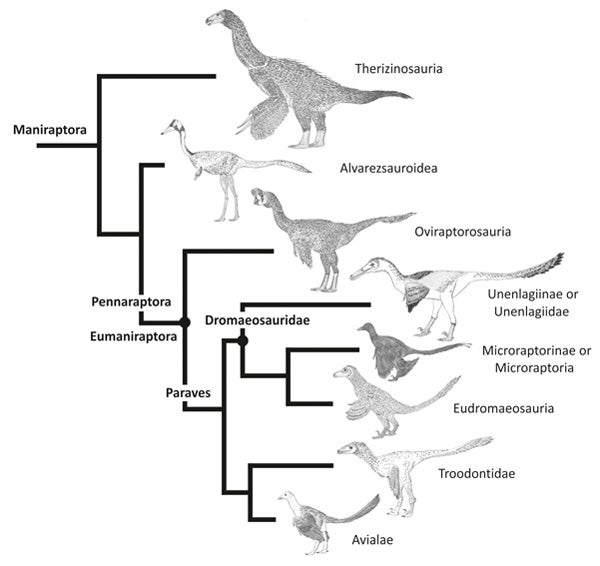
A hypothesis of maniraptoran phylogeny that depicts most of what we've seen so far (though this version depicts more complexity within Dromaeosauridae than what's been covered in the text). If you're wondering about scansoriopterygids - well, we'll get to them later. Image by Darren Naish, incorporating stuff used in that textbook project.
Ok, that’s the major groups introduced and discussed within our current understanding of how they might be related to one another. With this diversity and phylogenetic pattern in mind, let’s now start thinking about the shape of maniraptoran evolution in general. This is the topic we’ll begin to cover in the next article. Until then.
For previous Tet Zoo articles on Mesozoic maniraptorans and related dinosaur groups, see…
Luis Chiappe’s Glorified Dinosaurs: The Origin and Early Evolution of Birds
Did Velociraptor and Archaeopteryx climb trees? Claws and climbing in birds and other dinosaurs
Yi qi Is Neat But Might Not Have Been the Black Screaming Dino-Dragon of Death
Refs - -
Brusatte, S. L., Lloyd, G. T., Wang, S. C. & Norell, M. A. 2014. Gradual assembly of avian body plan culminated in rapid rates of evolution across the dinosaur-bird transition. Current Biology 24, 2386-2392.
Choiniere, J. N., Xu, X., Clark, J. M., Forster, C. A., Guo, Y. & Han, F. 2010. A basal alvarezsaurid theropod from the early Late Jurassic of Xinjiang, China. Science 327, 571-574.
Foth, C., Tischlinger, H. & Rauhut, O. W. M. 2014. New specimen of Archaeopteryx provides insights into the evolution of pennaceous feathers. Nature 511, 79-82.
Godefroit, P., Demuynck, H., Dyke, G., Hu, D., Escuillie, P. & Claeys, P. 2013. Reduced plumage and flight ability of a new Jurassic paravian theropod from China. Nature 498, 359-362.
Hu, D., Hou, L., Zhang, L. & Xu, X. 2009. A pre-Archaeopteryx troodontid theropod from China with long feathers on the metatarsus. Nature 461, 640-643.
Longrich, N. & Currie, P. J. 2008. Albertonykus borealis, a new alvarezsaur (Dinosauria: Theropoda) from the Early Maastrichtian of Alberta, Canada: implications for the systematics and ecology of the Alvarezsauridae. Cretaceous Research 30, 239-252.
Senter, P. 2005. Function in the stunted forelimbs of Mononykus olecranus (Theropoda), a dinosaurian anteater. Paleobiology 31, 373-381.